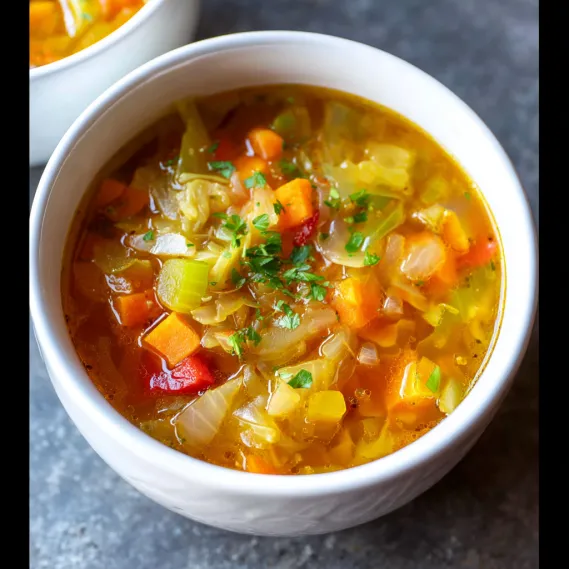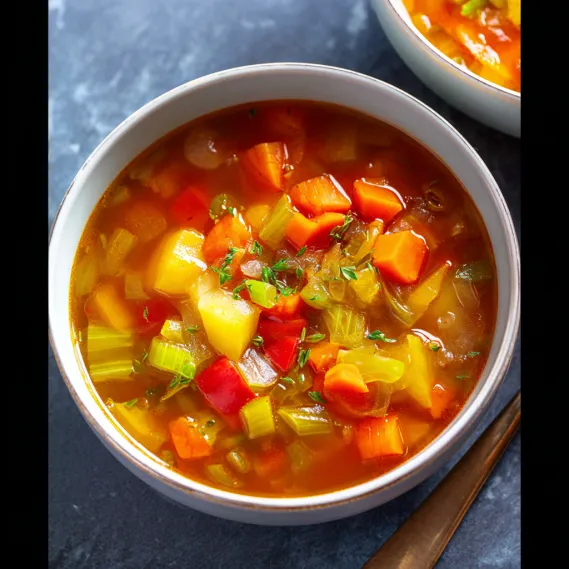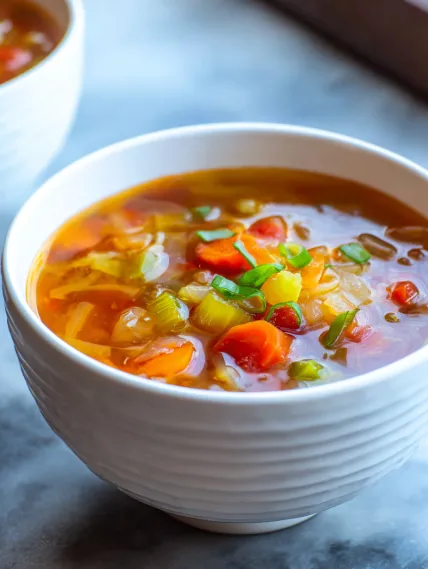 Pin
Pin
This simple homemade soup recipe transforms basic pantry ingredients into a comforting meal that warms both body and soul. The beauty of this classic soup lies in its versatility and simplicity, making it perfect for busy weeknights or lazy weekends when you crave something wholesome and satisfying.
I discovered the magic of this soup formula during my first apartment days when my cooking skills were minimal but my budget was even smaller. What started as necessity has become my go-to template for quick weeknight dinners that my whole family enjoys.
Ingredients
- Olive oil: creates the flavor foundation for the entire soup letting aromatics release their full potential
- Onion: delivers sweetness as it cooks down and forms the backbone of the soup
- Carrots: add natural sweetness, color, and valuable nutrients to the broth
- Celery: provides subtle aromatic qualities that round out the classic mirepoix base
- Garlic cloves: offer immune-boosting properties and depth of flavor; look for firm bulbs with tight skin
- Broth: either vegetable or chicken determines the character of your soup; homemade is wonderful but quality store-bought works perfectly
- Vegetables or protein: this is where you can get creative with seasonal produce or leftover proteins
- Salt and pepper: these simple seasonings bring everything together; freshly ground pepper makes a noticeable difference
How To Make Basic Soup
- Preparing the base:
- Heat your olive oil in a heavy-bottomed pot over medium heat until it shimmers but doesn't smoke. This usually takes about 1 minute and ensures your vegetables will sauté properly rather than steam.
- Creating the mirepoix:
- Add your diced onion, carrots, and celery to the hot oil, stirring occasionally to prevent sticking. Allow them to soften for approximately 5 minutes until the onions become translucent and slightly golden around the edges. This slow cooking process releases natural sugars that build the flavor foundation of your soup.
- Incorporating aromatics:
- Add the minced garlic to the softened vegetables and stir continuously for exactly one minute. Garlic burns quickly and becomes bitter, so watch carefully during this stage, cooking just until fragrant.
- Building the broth:
- Pour in your broth all at once, creating a sizzling sound as it hits the hot pot. Use a wooden spoon to scrape any flavorful bits from the bottom of the pot, then increase heat to bring the mixture to a gentle boil.
- Adding main ingredients:
- Once boiling, carefully add your chosen vegetables or protein, adjusting the timing based on what you're using. Harder vegetables like potatoes need longer, while quick-cooking items like spinach should be added near the end.
- Simmering to perfection:
- Reduce the heat until the soup maintains a gentle simmer with occasional small bubbles breaking the surface. Cover partially with a lid and allow to simmer for 15 to 20 minutes until all ingredients are tender and flavors have melded together.
- Final seasoning:
- Turn off the heat and taste your creation. Add salt and pepper gradually, tasting after each addition until the flavors brighten and become cohesive. Remember you can always add more seasoning but you cannot remove it.

The mirepoix base of onion, carrot, and celery is my favorite part of this recipe and represents centuries of culinary wisdom. My grandmother taught me that taking time with this step is what separates a good soup from an exceptional one. The aroma that fills the kitchen during these first few minutes of cooking instantly transports me back to her warm, cozy kitchen where I first learned to cook.
Storage Solutions
This soup keeps beautifully in the refrigerator for up to 4 days in an airtight container, making it perfect for meal prep. The flavors actually improve after a day as ingredients have time to meld together. For longer storage, freeze portions in individual containers for up to 3 months. Allow frozen soup to thaw overnight in the refrigerator before gently reheating on the stovetop over medium-low heat, stirring occasionally to ensure even warming.
Creative Variations
Transform this basic recipe into countless different soups by changing just a few key elements. For a Mediterranean twist, add white beans, oregano, and finish with a drizzle of olive oil. Create an Asian-inspired version with ginger, lemongrass, and a splash of coconut milk. Turn it into a hearty winter meal by adding barley and mushrooms. The possibilities are truly endless, which is why this recipe deserves a permanent place in your cooking repertoire.

Nutrition Boosters
Enhance the nutritional profile of your soup with strategic additions that pack both flavor and health benefits. Stir in a handful of chopped leafy greens like kale or spinach during the last few minutes of cooking. Add cooked quinoa or brown rice for staying power and extra protein. A tablespoon of nutritional yeast stirred in at the end adds a cheesy flavor while providing B vitamins. Fresh herbs sprinkled just before serving contribute antioxidants along with bright fresh flavor.
Serving Suggestions
This versatile soup pairs beautifully with many accompaniments. A slice of crusty whole grain bread for dipping is classic and satisfying. For a complete meal, serve smaller portions alongside a crisp green salad dressed with lemon juice and olive oil. Garnish each bowl thoughtfully with fresh herbs, a drizzle of quality olive oil, or a light grating of hard cheese. For special occasions, consider serving in hollowed-out bread bowls for a presentation that delights both children and adults alike.
Recipe FAQs
- → What vegetables work best for this soup?
Classic choices include carrots, celery, onions, and garlic. You can also add vegetables like zucchini, spinach, or bell peppers for variety.
- → Can I use a different oil instead of olive oil?
Yes, you can use other oils like vegetable oil, avocado oil, or even butter to sauté the ingredients.
- → How do I make the soup vegetarian or vegan?
To make it vegetarian, use vegetable broth instead of chicken or beef broth. For a vegan version, ensure all your ingredients are plant-based.
- → What proteins can I add to this soup?
Common protein options include shredded chicken, cooked beans, tofu, or even lentils. Choose what suits your taste and diet.
- → How do I store leftover soup?
Store leftover soup in an airtight container in the refrigerator for up to 3–4 days. Reheat on the stovetop or in the microwave.
- → Can I freeze this soup?
Yes, you can freeze the soup in freezer-safe containers for up to 3 months. Thaw in the refrigerator before reheating.
